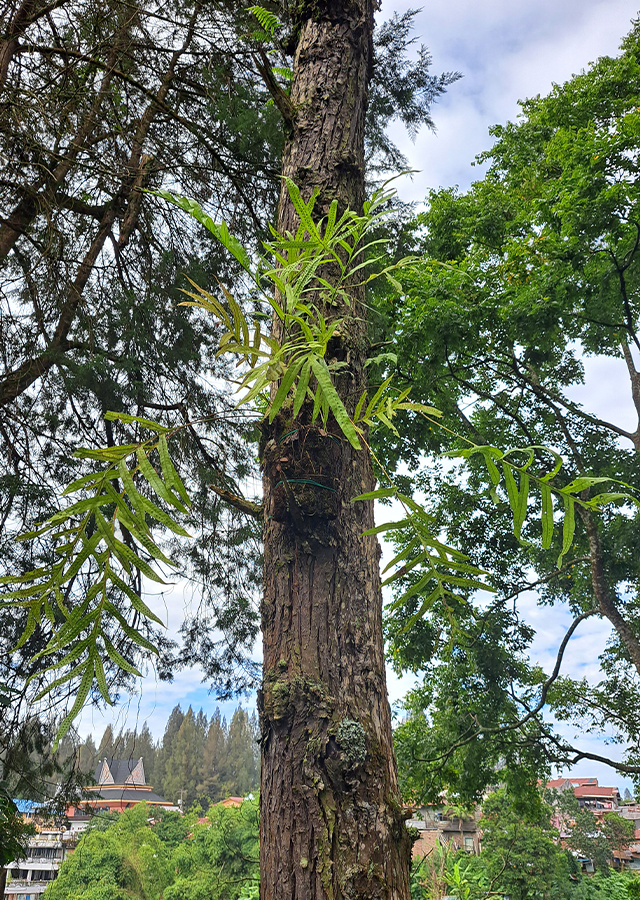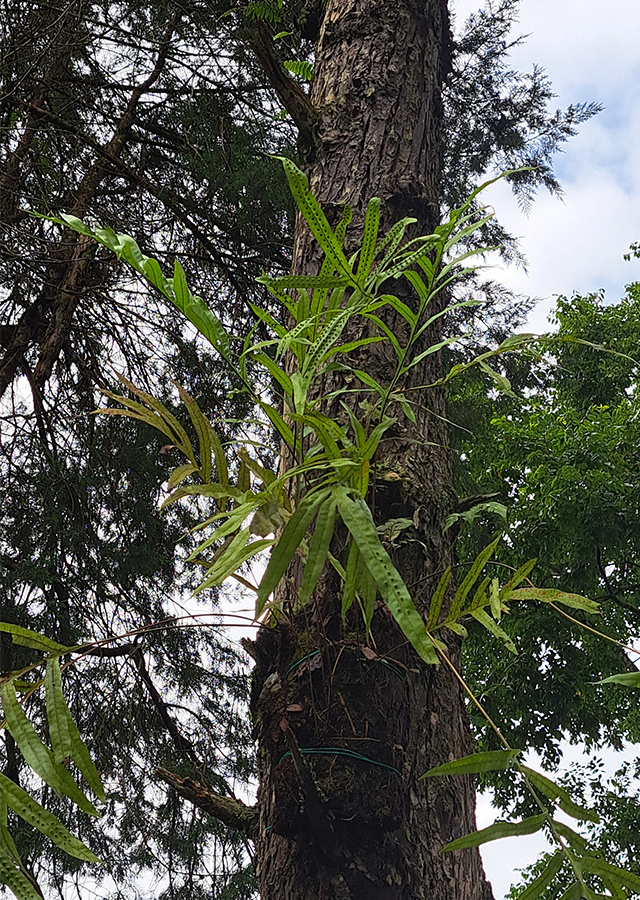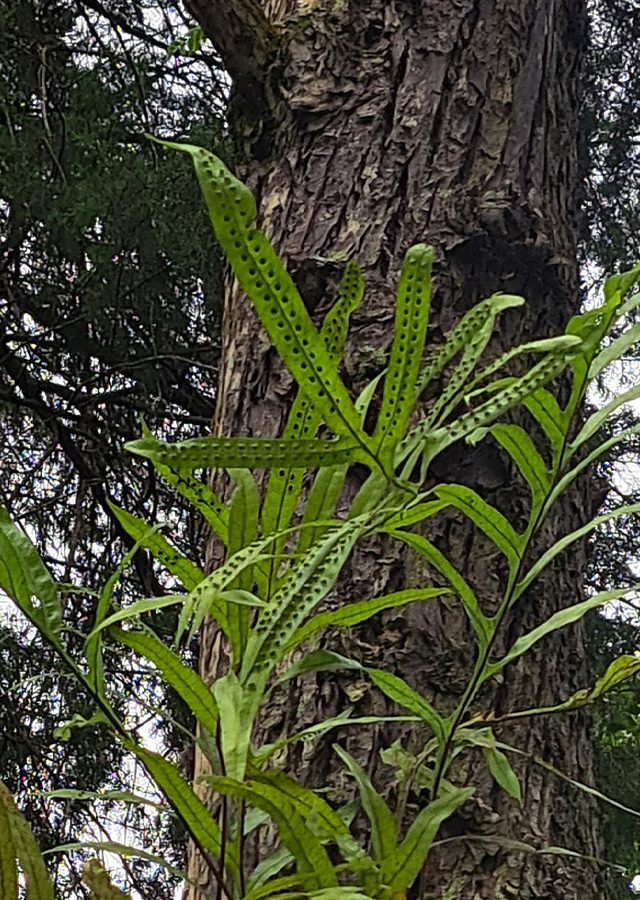Wart fern
Phymatosorus scolopendria (Burm.f.) Pic.Serm.
Polypodiaceae
Location in our garden
Green House



Synonym
Phymatodes scolopendria (Burm.f) Ching
Microsorum scolopendria (Burm.f.) Copel.
Polypodium scolopendria Burm.f.
Habitus
Fern. Perennial epiphyte with wide, creeping and glabrous rhizomes up to 10 mm in diameter
Part Used
Leaves
Roots
Rhizome
Growing Requirements
Need Shade
Drought Resistant
Habitat
Forest
Coastal
Rocky Areas
Overview
Phymatosorus scolopendria is distributed throughout the tropics of the Old World, including tropical Africa, South and South-East Asia, Australia (Northern Territory, Queensland) and most tropical islands in the Pacific. P. scolopendria are widely cultivated as garden or indoor plants. Several species are also used for medicinal purposes. In Hawai, the plants are used to scent tapa cloth, to adorn hula altars and dancers, and used for making lei.
Vernacular Names
Oknawa ura-boshi (Japanese), Sakat hitam (Malay), Ráng o chìm luoi hươu (Vietnamese), Khuut chakkhep (Thai).
Agroecology
In South-East Asia P. scolopendria is a common epiphyte on old trees in open locations, on the trunks of plantation oil palms, sometimes occurring on rocks and earth banks in full sunlight, from the lowlands up to 2100 m altitude. In South Africa, wart ferns or P. scolopendria occur mostly in upland temperate or tropical evergreen or coastal forests, ranging from near sea level to approximately 750 m. The region experiences a seasonal rainfall of more than 1 000 mm per annum. This is a hardy species and easy to cultivate in a wide range of habitats. It is best cultivated outdoors in light shade, but it will also tolerate direct sunlight for part of the day. In older gardens it often establishes on brick or stone walls, or on trees, especially palms. Although it will tolerate short, dry spells it is best cultivated in conditions which remain constantly moist.
Morphology
- Rhizomes - terete, white waxy, with sclerified circumvascular sheaths and scattered sclerenchyma strands, scales peltate, ovate to triangular, 2-7 mm × 0.6-1.4 mm.
- Leaves - simple, entire or pinnatifid with 1-9 lobes at each side of the midrib, light green, herbaceous; petiole up to 55 cm long; lamina or lobes narrowly elliptical, up to 45 cm × 8 cm, margin entire, apex acuminate.
- Sori - 1-3 rows between the midrib and the leaf margin, deeply sunken and visible as protrusions on the upper surface.
Cultivation
Propagation of Microsorum is possible by spores and by rhizome cuttings. Rhizome cuttings should be buried not deeper than 5 cm. Spores are sown on a sterilized medium and kept in a very high relative humidity. Sporophytes are transplanted in groups when they are about 1 cm tall and again transplanted individually when they are taller than 3 cm.
Chemical Constituents
Glycirrhizin, saponin, ecdysone, 20-hydroxyecdysone, makisterones A and C, inokosterone, amarasterone A, 24,28-diepi-cyasterone.
Traditional Medicinal Uses
- In Indo-China, the Annamites are reported to use the young leaves of the fern for chronic diarrhea.
- In New Guinea, plant is heated over fire and the smoke inhaled to relieve catarrh.
- In Tonga, leaf infusion used to treat filariasis in infants.
- Pounded leaves applied to boils.
- In Samoa, frond used in treated of headaches and stomach catarrh. Lotion of fronts used on wounds, sores, and abscesses.
- Pounded leaves mixed with young coconut pulp used as poultice for arthritis.
- Pounded leaves in coconut oil used in massage to induce postnatal discharge.
- In the Cook Islands, crushed rhizomes used to treat fistula and other internal ailments. Also used as purgative.
- In Fiji, leaf juice used to treat stomachache, breast swelling associated with breastfeeding, and boils.
- Infusion of leaves and roots taken by women as postpartum tonic.
- Infusion of leaves used for postpartum depression.
- Mixed leaves decoction of Phymatosorus scolopendria and Hoya australis used as postpartum tonic and to treat body aches and headaches.
Part Used
Reference Sources
- StuartXchange. Philippine Medicinal Plants. 2018. Microsorum scolopendria. http://www.stuartxchange.org/SerpentFern. 26-08-22.
- Plant Resources of South-East Asia. 2016. Microsorum scolopendria. https://uses.plantnet-project.org/en/Microsorum_(PROSEA). 26-08-22.
- National Parks. Flora & Fauna Web. 2022. Microsorum scolopendria. https://www.nparks.gov.sg/florafaunaweb/flora/1/5/1560. 26-08-22.
- Roux, Koos. South African National Biodiversity Institute. Microsorum. 2005. http://pza.sanbi.org/microsorum. 26-08-22.

